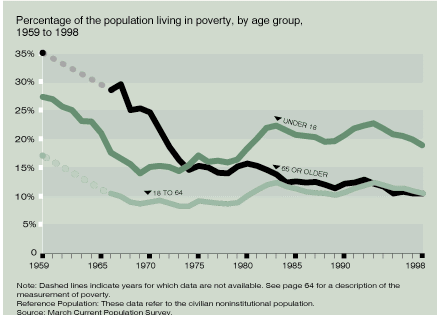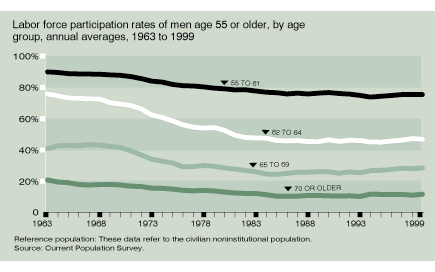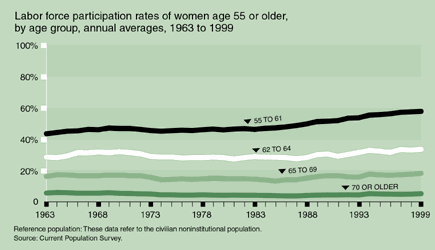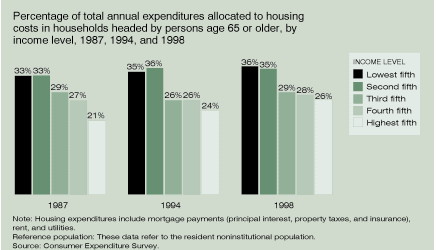Economics
Indicator
6 - Poverty
Indicator
7 - Income Distribution
Indicator 8 - Sources of Income
Indicator
9 - Net
Worth
Indicator
10 - Participation in the Labor Force
Indicator
11 - Housing
Expenditures
The official measure of poverty is based on a family’s
annual money income. To determine who is poor, the U.S. Census Bureau compares
family income with a set of poverty thresholds, which vary by family size and
composition. Persons identified as living in poverty are at risk of having
inadequate resources for food, housing, health care, and other needs.

- In
1959, 35 percent of persons age 65 or older lived in families with money
income below the poverty line. By 1998, the percentage of the older
population living in poverty had declined to 11 percent.
- The
relative poverty rates of the older population (age 65 or older), persons of
working age (age 18 to 64), and children
(under age 18) have changed dramatically. In 1959, older persons had
the highest poverty rate (35 percent), followed by children (27 percent),
and working-age persons (17 percent). By 1998, an equal percentage of the
older population and working-age persons lived in poverty (11 percent),
while the poverty rate of children remained at a relatively high level (19
percent).
- Among
older Americans, the poverty rate is higher at older ages. In 1998, poverty
rates were 9 percent for persons ages 65 to 74, 12 percent for persons ages
75 to 84, and 14 percent for persons age 85 or older.
- Among
the older population, poverty rates are higher among women (13 percent) than
among men (7 percent), among the nonmarried (17 percent) compared with the
married (5 percent), and among minorities compared with non-Hispanic white
persons. In 1998, divorced black women ages 65 to 74 had a poverty rate of
47 percent, one of the highest rates for any subgroup of older Americans.[10]
Data
for this indicator can be found in Tables 6a and 6b.
The
percentage of persons living below the poverty line does not give a complete
picture of the changing economic situation of older Americans. Analyzing the
income distribution of the population age 65 and older provides important
insights into the economic well-being of this population.

- Since
1974, the percentage of older persons in extreme poverty has been fairly
constant at around 2 percent. The percentage in poverty declined from 13
percent in 1974 to 8 percent in 1998. The percentage of older persons in the
low-income group declined from 35 percent in 1974 to 27 percent in 1998. The
medium- and high-income groups together accounted for half of all older
persons in 1974, but accounted for almost two-thirds of older persons in
1998.
- In
1998, persons with medium income made up the largest share of older persons
by income group (35 percent). Equal shares of older persons were in families
with low and high income (27 percent).
- In
1998, persons age 75 or older were as likely as those ages 65 to 74 to be
extremely poor, more likely to be poor or low-income (40 percent, compared
with 27 percent), and less likely to be medium- or high-income (58 percent,
compared with 70 percent).[11]
Data for this indicator can be found in Table 7.
Most
older Americans are retired from full-time work. Social Security was developed
as a floor of protection for their incomes, to be supplemented by other pension
income, income from assets, and to some extent, continued earnings. Over time,
Social Security has taken on a greater importance to many older Americans.

- Since
the early 1960s, the proportion of income for older Americans derived from
Social Security and pensions has increased, and the proportion from earnings
has declined. The share of income from assets peaked in the mid-1980s and
has generally declined since then.
- In
1998, Social Security benefits provided about two-fifths of the income of
older persons; and asset income, pensions and personal earnings each
provided about one-fifth of total income.
- Pension
coverage expanded dramatically in the two decades after World War II, and
private pensions accounted for an increasing proportion of income for older
persons during the 1960s and early 1970s. Since then, the coverage rate has
been stable at about 50 percent of all workers on their current jobs.[12]
- There
has been a major shift in the type of pensions provided by employers, from
defined-benefit plans (in which a specified benefit amount is typically paid
as a lifetime annuity), to defined-contribution plans such as 401(k) plans
(in which the amount of the future benefit varies depending on investment
earnings). In 1975, only 6 percent of private sector employees depended
primarily on defined-contribution plans for their employer-sponsored
pension. By 1994, this had increased to 21 percent. Over the same period,
primary coverage under defined-benefit plans fell from 39 percent to 24
percent.[13]

- Among
older Americans in the lowest fifth of the income distribution, Social
Security accounts for 82 percent of income, and public assistance accounts
for another 10 percent. For those whose income is in the highest income
category, Social Security and pensions each account for about a fifth of
income, and asset income and earnings each account for about 30 percent of
total income.
- For
persons age 85 or older, Social Security and assets account for a larger
proportion of total income, and earnings and pensions a smaller proportion,
compared with persons ages 65 to 69.[14]
Data
for this indicator can be found in Tables 8a and 8b.
Net worth (the value of real estate, stocks, bonds and
other assets minus outstanding debts) is an important indicator of economic
security and well-being. Greater net worth allows a family to maintain its
standard of living when income falls because of job loss, health problems, or
family changes such as divorce or widowhood.

- Between
1984 and 1999, the median net worth among households headed by persons age
65 or older increased by 69 percent, while the median net worth for
households headed by persons ages 45 to 54 declined by 23 percent over the
same period. Although there is general agreement that net worth among
households headed by older persons has increased over time, different data
sources disagree about the size of this increase.[15]
- Most
striking is the disparity in net worth between black and white households
headed by older Americans. In 1999, median net worth among older black
households was estimated to be about $13,000, compared with $181,000 among
older white households.

- In
1999, household heads age 65 or older with at least some college reported a
median household net worth more than four times that of heads of household
without a high school diploma.
- Between
1984 and 1999, the median net worth for households headed by persons without
a high school diploma increased by only 21 percent, compared with a 48
percent increase among households headed by persons with at least some
college.
Data
for this indicator can be found in Table 9.
Indicator
10 - Participation in the Labor Force
The
labor force participation rate is the percentage of a group that is in the labor
force—that is, working (employed) or actively looking for work (unemployed).
Some older Americans work out of economic necessity. Others may be attracted by
the social contact, intellectual challenges, or sense of value to the community
that work often provides.

- Between
1963 and 1999, labor force participation rates declined from 90 percent to
75 percent among men ages 55 to 61, and declined from 76 percent to 47
percent among men ages 62 to 64. The participation rate for men age 70 or
older declined from 21 percent in 1963 to less than 12 percent in 1999. Most
of these declines occurred prior to 1980.
- The
decline in labor force participation before the 1980s has been attributed to
several factors. The youngest age of eligibility for Social Security
benefits was dropped from 65 to 62 in the early 1960s. Greater wealth also
allowed older Americans to retire earlier.[16] The more recent
stability of participation rates has been explained by the elimination of
mandatory retirement laws, liberalization of the Social Security “earnings
test” (the reduction of Social Security benefits as earnings exceed
specified amounts) and gradual increases in the delayed retirement credit
for Social Security beneficiaries.[17]

- In
contrast to the rates for men, labor force participation rates have risen
among most women age 55 or
older during recent decades. The increase was greatest among women ages 55
to 61. Rates have been stable at about 5 percent among women age 70 or
older.
- Labor
force participation rates for older women reflect changes in the work
experience of successive generations of women. Many women now in their 60s
and 70s did not work outside the home when they were younger, or they moved
in and out of the labor force.[18] As new cohorts of women approach
older ages, they are participating in the labor force at higher rates than
previous generations. As a result, in 1999, 58 percent of women ages 55 to
61 were in the labor force, compared with 44 percent of women ages 55 to 61
in 1963. The labor force participation rate increased from 29 percent to 34
percent among women ages 62 to 64.
- As
a result of the decline in men’s labor force participation and the
stability or increase in women’s participation, there has been a
substantial narrowing of the difference in labor force participation between
men and women. Among persons ages 65 to 69, the gap between men’s and
women’s rates in 1999 was 10 percentage points, compared with 24
percentage points in 1963.
Data
for this indicator can be found in Table 10.
Most older people live in adequate, affordable housing,[19]
but some older Americans need to allocate a large proportion of their total
expenditures to housing. When housing expenditures comprise a relatively high
proportion of total expenditures, less money is available for health care,
savings, and other vital goods and services.

- Between
1987 and 1998, the percentage of expenditures devoted to housing rose
slightly among households headed by older Americans in all but the middle
income category, which remained the same.
- In
1998, households with the lowest level of income spent an average of $4,686
on housing while households
with the highest level of income spent $10,119 on average for housing.
- The
burden of housing costs relative to all expenditures declines as income
increases. Among households
headed by persons age 65 or older, those with income in the bottom fifth of
the income distribution in 1998 allocated an average of 36 percent of all
expenditures to basic housing. That proportion fell to 29 percent for those
in the middle income fifth, and to 26 percent for those in the top fifth of
the income distribution.
Data
for this indicator can be found in Table 11.
Contacts:










